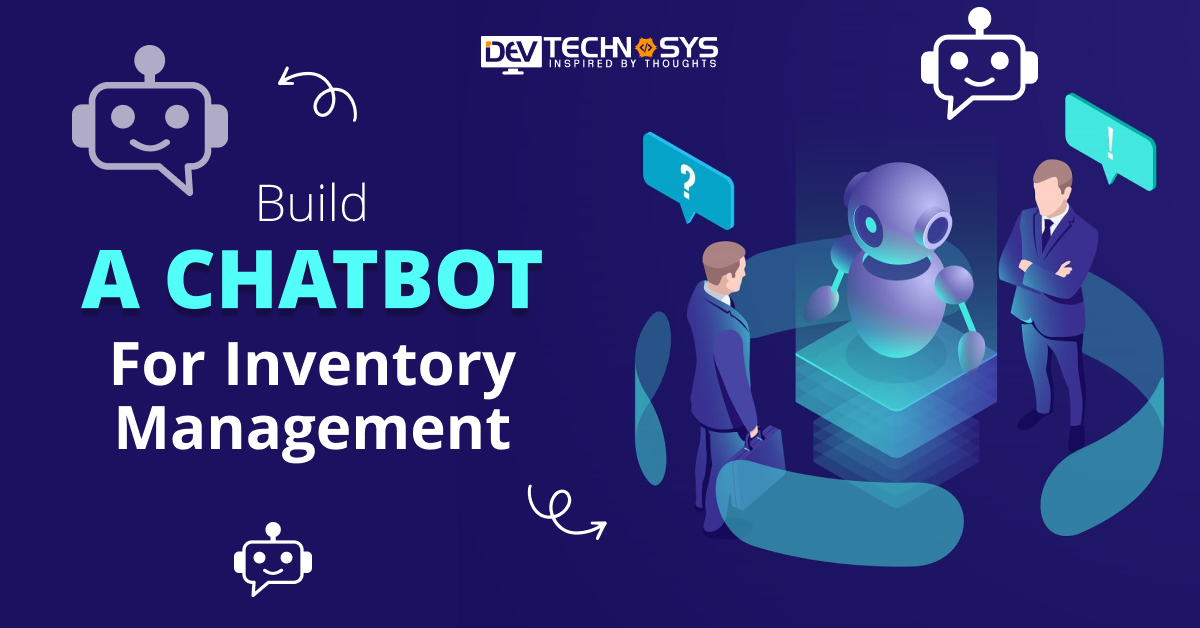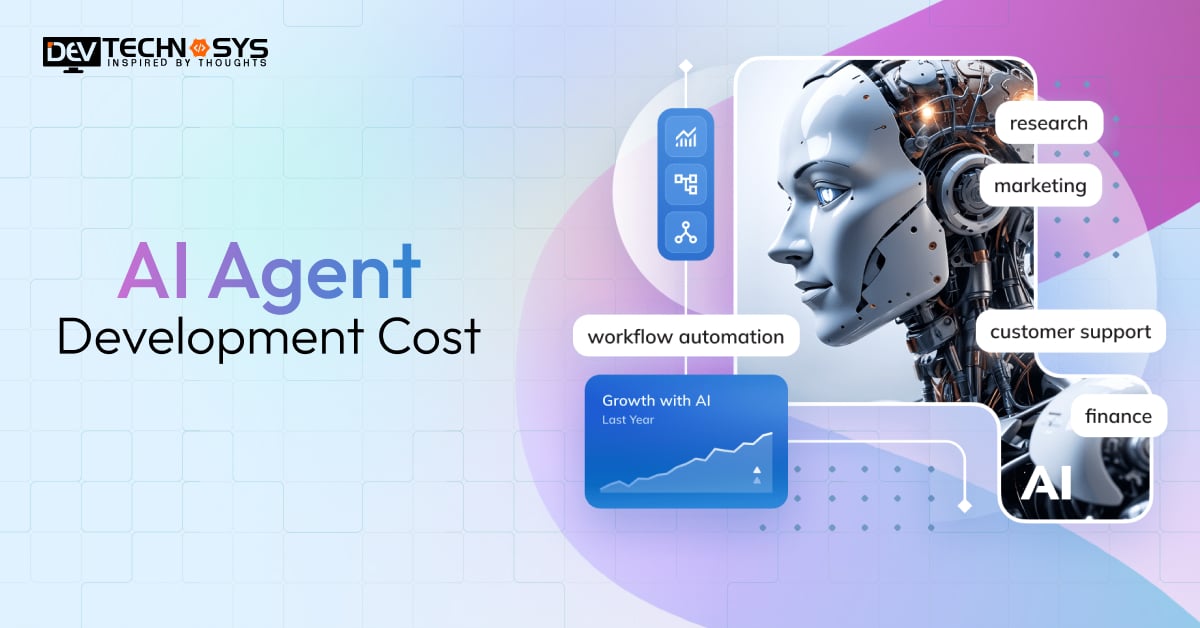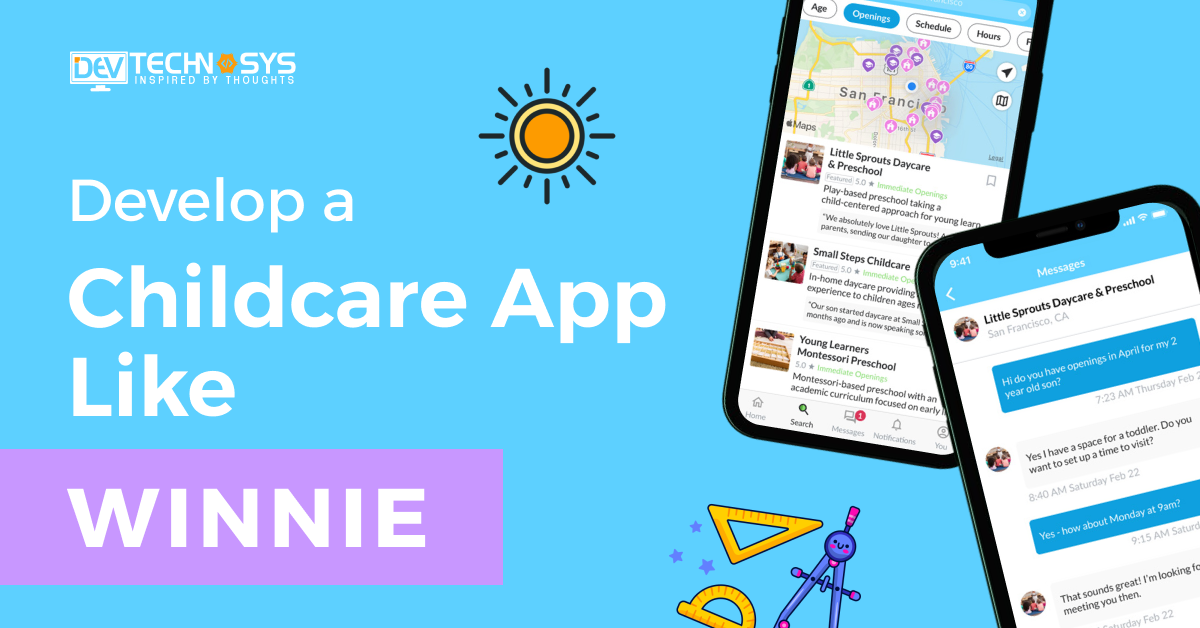Keeping track of inventory can feel like juggling a hundred things at once, items coming in, going out, running low, or sometimes disappearing altogether.
If you have ever lost hours sorting through spreadsheets or missed a stock update, you are aware of how easily things can get out of hand. This is where technology comes in. It won’t replace your team, but it will make it stronger.
One of the best moves an entrepreneur can make today is to build a chatbot for inventory management. Imagine a friendly assistant that works 24/7, answers inventory questions instantly, alerts you before stock runs out, and even updates records automatically without breaking a sweat.
In this blog, we’ll walk you through the steps to create a chatbot that’s not only functional but also genuinely helpful for tracking and managing your inventory efficiently.
So, let’s begin!
What is an Inventory Management Chatbot?
An inventory management chatbot is a smart digital assistant that helps businesses track and manage their stock. It can answer questions, check product availability, update inventory levels, and send alerts when items are low or out of stock.
The chatbot in supply chain management software development works through chat platforms and responds instantly, saving time and reducing human error. It helps store owners or managers control their products in real time, whether in a warehouse or a retail shop.
Future Predictions & Projections of Inventory Management
- In 2024, SAP Extended Warehouse Management was the world leader in warehouse management software, with a 21% market share.
- The market for inventory management is forecasted to boost to more than $7.2 billion by 2028.
- 63% of store businesses in the U.S. get their inventory right.
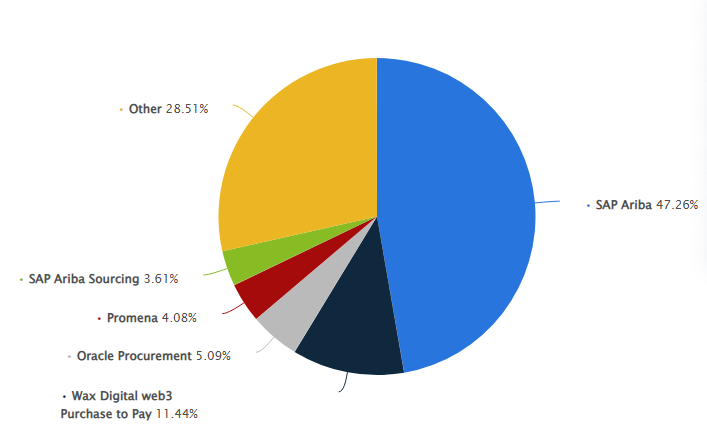
Source: Statista
- Logistics gases are expected to drop by 10% to 12% by 2025.
- 36% of people working in the supply chain are improving their inventory handling.
How Does an Inventory Management Chatbot Work?
If you are planning to develop an inventory management chatbot, it is vital to know its working procedure. This will assist you know how users can operate it. So, we have explained the working functionality of a chatbot for inventory management.
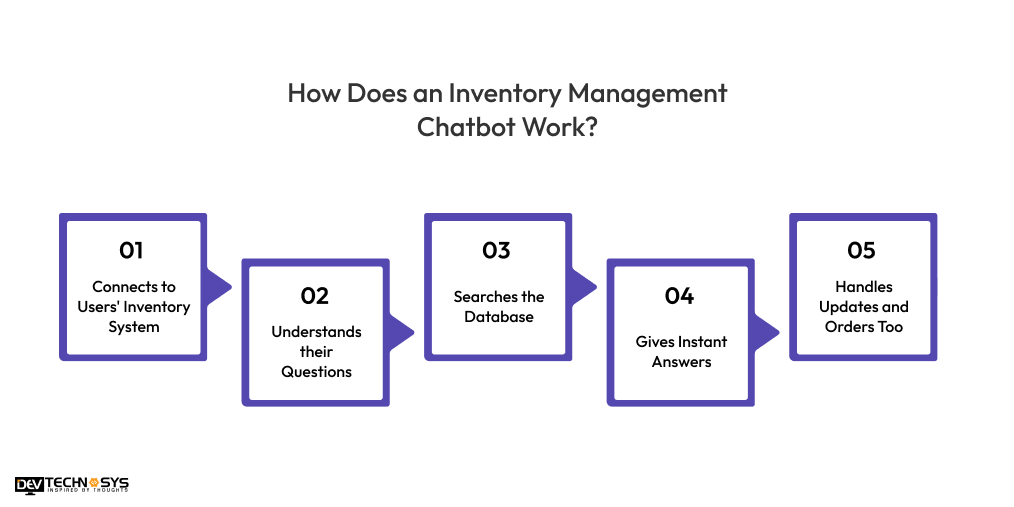
1. Connects to Users’ Inventory System
The chatbot links with users’ inventory software or database. This lets it see real-time stock levels, item names, and other details like a staff member would.
2. Understands their Questions
Using natural language processing services, the chatbot can understand everyday language. So, when users ask, “How many red shirts are in stock?” it knows what they’re looking for.
3. Searches the Database
Once it understands a user’s question, the chatbot quickly checks its inventory system to find the correct answer, whether checking stock, item location, or delivery status.
4. Gives Instant Answers
In just a few seconds, it sends a clear and helpful reply, such as “You have 45 red shirts in stock.” This saves users time by avoiding manual checks.
5. Handles Updates and Orders Too
Some advanced chatbots can also update stock, reorder items, or alert users when inventory runs low, all through a simple conversation.
Steps to Build A Chatbot for Inventory Management
Creating a chatbot to help with inventory management can make your business run more smoothly. It can help track stock levels, check item availability, update inventory, and even place orders. Here is the process to create a chatbot for inventory management.
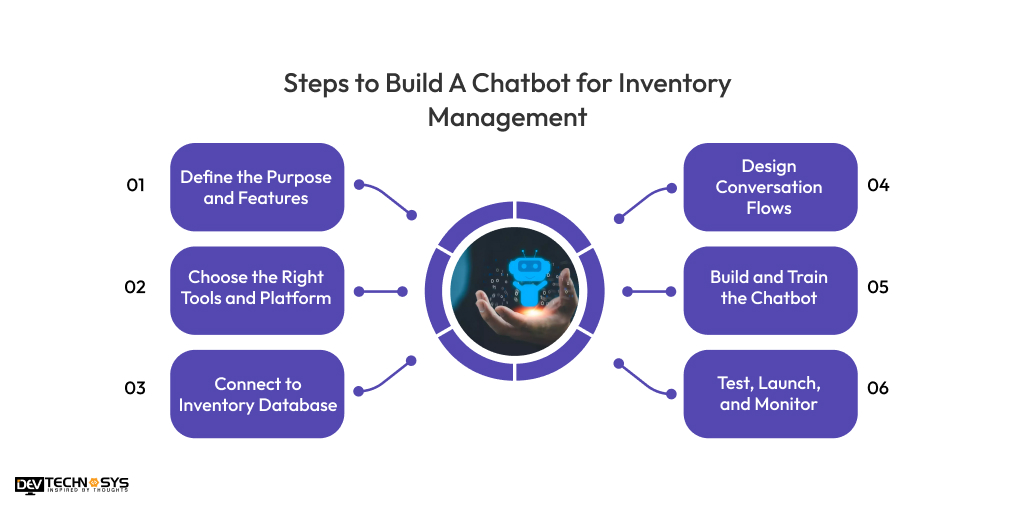
1. Define the Purpose and Features
Before you build a chatbot for inventory management, you should clearly evaluate what it must do. Is it meant to check stock levels, update inventory, notify of low stock, or place reorders? Decide on the main goals of the bot.
Will it use text commands, buttons, or voice input? A clear plan helps ensure the chatbot is helpful and focused on solving real inventory problems.
|
2. Choose the Right Tools and Platform
Next, the neural network development company will pick the tools you’ll use to develop an AI chatbot for inventory management. If you’re a beginner, platforms like Dialogflow, Microsoft Bot Framework, or Chatfuel can help you build a bot without much coding.
For more control, you can code it using Python with libraries. Also, decide where your chatbot will live, on WhatsApp, a website, or a mobile app.
|
3. Connect to Inventory Database
To develop a chatbot from scratch, you need access to your inventory data. This means connecting it to your inventory management system or database, such as MySQL, Google Sheets, or an ERP system.
This connection lets the bot fetch real-time data about stock levels, item details, and incoming or outgoing shipments. You may need to build a chatbot for inventory management or scripts to enable smooth data access.
|
4. Design Conversation Flows
Think through the conversations users might have with the bot. What happens if someone asks, “Do we have more of Product A?” or “How many products are left?” Create simple question-and-answer patterns for each type of request.
Tools like flowcharts or chatbot design platforms can help you visualize these interactions and cover common use cases like stock updates, low inventory alerts, and product searches.
|
5. Build and Train the Chatbot
Now it’s time actually to build a chatbot for inventory management. Set the intent of what the user wants to do and train the bot with sample phrases that users might say. The software development company can add clear, helpful, and direct responses.
If your bot uses AI, it will need training data to understand user inputs accurately. You should also test the bot regularly to fix mistakes and improve its understanding.
|
6. Test, Launch, and Monitor
Finally, test your chatbot with real users. Try different types of questions to see how well it responds. After testing, launch the chatbot on your chosen platform.
Keep tracking its performance, checking out errors, gathering reviews, and updating it as needed. Over time, you can add more features or improve its language skills to make it even more helpful in managing inventory.
|
Key Features of Inventory Management Chatbot Development
Inventory management chatbot development involves integrating crucial features to ensure it efficiently helps track, manage, and optimize inventory processes. Below are the major features to think about when you build an AI chatbot for inventory management.
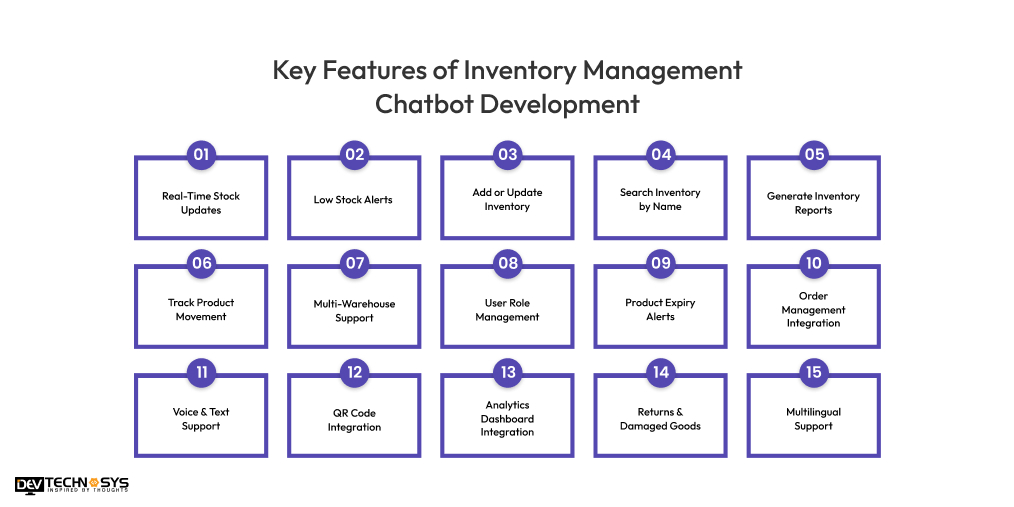
-
Real-Time Stock Updates
The chatbot can provide real-time updates about the stock levels of any product. Users can ask, “How many units of Product X do we have?” and get instant answers.
-
Low Stock Alerts
It can automatically alert users when stocks drop below a set criteria. This asset tracking software development helps avoid stockouts and keeps the inventory running smoothly.
-
Add or Update Inventory
The chatbot inventory management allows users to add new products or update existing inventory directly through conversation, like “Add 50 units of Product Y.”
-
Search Inventory by Name
Users can search for products by name or category. The chatbot can fetch and display the relevant product details instantly.
-
Generate Inventory Reports
When you build a chatbot for inventory management, you can generate daily, weekly, or monthly inventory reports and even send them via email or download links.
-
Track Product Movement
The chatbot can track product inflows and outflows, helping managers understand what’s coming in and going out.
-
Multi-Warehouse Support
If your business uses multiple warehouses, the chatbot development services provider can check and manage stock levels separately for each one.
-
User Role Management
Admins can control who has access to what. For example, a chatbot in warehousing and supply chain staff can update stock, while managers can view reports.
-
Product Expiry Alerts
If you manage perishable goods, the virtual assistant for inventory management can send alerts when items are nearing their expiration dates.
-
Order Management Integration
The chatbot can integrate with order management systems to track pending, dispatched, or completed orders and update inventory accordingly.
-
Voice & Text Support
Users can interact with the chatbot by typing or using voice commands, making it more accessible for field workers or mobile users.
-
QR Code Integration
Users can scan barcodes or QR codes through their mobile devices to quickly add or check products in the inventory.
-
Analytics Dashboard Integration
The chatbot inventory management can link with an analytics dashboard to show trends, such as fast-moving or slow-moving items, helping with smarter purchasing decisions.
-
Returns & Damaged Goods
It can manage returns and damaged items by allowing users to log these and adjust inventory records automatically.
-
Multilingual Support
If your team speaks different languages, the virtual assistant for inventory management can offer support in multiple languages, improving usability for everyone.
5 Best AI Chatbots for Inventory Management
If you are seeking the best inventory management software with a chatbot feature, check out the table below.
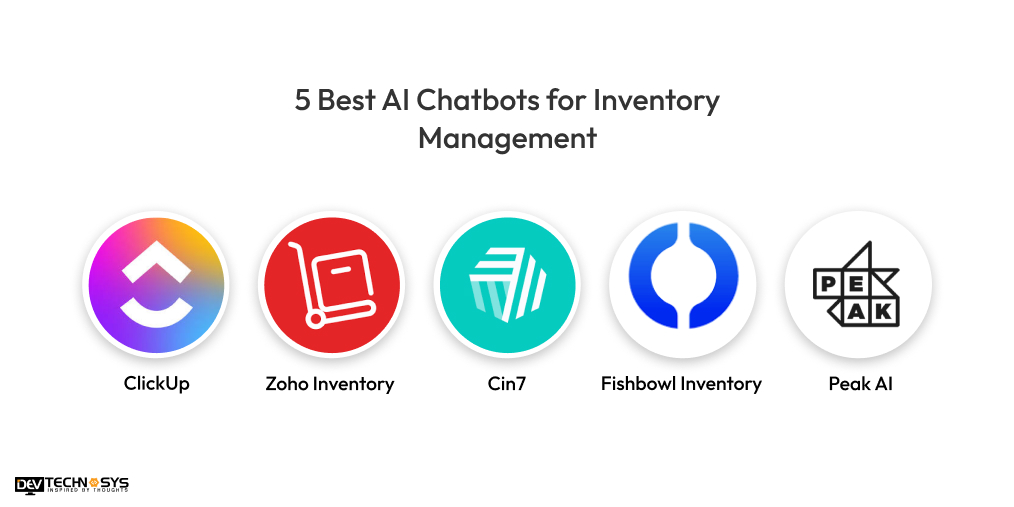
Top AI Chatbot for Inventory Management |
Features |
User Ratings |
Ideal For |
| ClickUp | AI-powered task automation, demand forecasting, and inventory templates. | 4.7 | Teams seeking customizable workflows. |
| Zoho Inventory | AI-driven demand forecasting, automated order management, and multi-channel support. | 4.5 | Small to medium-sized businesses. |
| Cin7 | ForesightAI for demand forecasting, automated purchase orders, and 700+ integrations. | 4.2 | Retailers and wholesalers. |
| Fishbowl Inventory | AI Insights for reporting, forecasting, and the Athena AI assistant. | 4.3 | Manufacturers using QuickBooks or Xero. |
| Peak AI | Custom AI solutions for demand forecasting, inventory optimization, and replenishment. | 4.0 | Enterprises need tailored AI solutions. |
How Much Does It Cost to Develop A Chatbot for Inventory Management?
The cost to build a chatbot for inventory management can range between $10,000 – $25,000 or more. The inventory management chatbot development cost can vary as per your business needs and level of customization.
If it is simple, the cost to develop a chatbot for inventory management will be less. However, if you want customizations, then it will cost more. So, it is crucial to take assistance with an ML development company and then set proper budget planning.
Now let’s know about variables influencing the chatbot for inventory management development cost.
1. Complexity of Features
If the chatbot needs advanced features like NLP or integration with multiple inventory systems, it will cost more. Simple tasks like checking stock levels or placing orders are cheaper, while more complex tasks add to the inventory management chatbot development cost clone.
Complexity Level |
Features |
Estimated Cost |
| Basic | Simple FAQs related to inventory | $10,000 – $15,000 |
| Basic inventory look-up | ||
| Predefined responses based on keywords | ||
| Medium | Natural Language Understanding for more complex queries. | $15,000 – $20,000 |
| Integration with basic inventory management systems | ||
| Real-time inventory status updates. | ||
| Advanced | Sophisticated NLU and Natural Language Processing for contextual understanding. | $20,000 – $30,000+ |
| Predictive analytics for demand forecasting. | ||
| Handling complex inventory-related tasks |
2. Customization Level
A basic virtual assistant for inventory management with standard responses is cheaper, while one tailored to your business needs, like custom workflows, reporting, etc, will increase the cost to build a chatbot. More customization means more time and effort for AI chatbot inventory management development.
Customization Level |
Estimated Cost |
Development Time |
| Basic | $8,000 – $12,000 | 2 – 4 weeks |
| Medium | $12,000 – $18,000 | 4 – 8 weeks |
| Advanced | $18,000 – $25,000 | 8 – 12+ weeks |
| Highly Custom | $25,000 – 30,000+ | 12+ weeks |
3. Development Team
The cost to build a chatbot for inventory management also depends on whether you hire freelancers, a local development agency, or a larger company. An experienced AI development company tends to charge higher rates. Location matters too; developers in some countries charge more than in others.
Location |
Average Hourly Rate ($) |
| North America (USA/Canada) | 100 – 250+ |
| Western Europe | 80 – 200+ |
| Central and Eastern Europe | 50 – 100 |
| South America | 40 – 90 |
| India | 15 – 25 |
4. Maintenance and Support
After the chatbot is built, you’ll need ongoing support to fix issues, update features, or adapt to new inventory processes. This maintenance can be an additional inventory management chatbot development cost over time, depending on your chosen service agreement.
Category |
Estimated Annual Cost |
| Basic System Maintenance | $1,000 – $5,000 |
| Security Updates | $800 – $1000+ |
| Integration Maintenance | $1,500 – $2,000+ |
| Monitoring & Analytics | $500 – $1,000+ |
| Technical Support | $500 – $2,000+ |
How To Monetize Your AI Chatbots in Supply Chain Management?
Monetizing AI chatbots in supply chain management is an excellent way to unlock value from the technology you’ve built. You should check out the major strategies to earn revenue from your chatbot system:
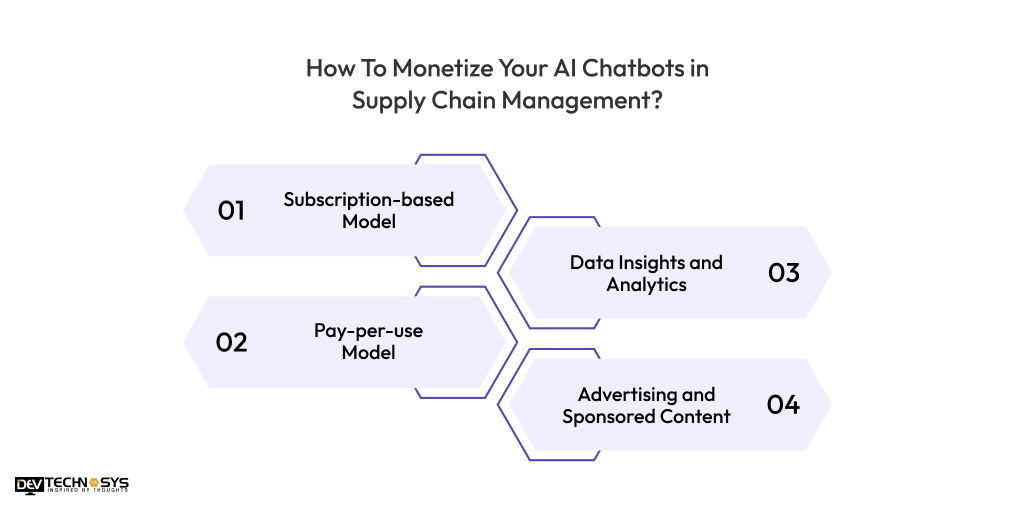
1. Subscription-based Model
A subscription model is one of the most straightforward ways to monetize your AI chatbots in modern supply chain operations. This involves offering your virtual assistant for inventory management as a service (SaaS) and charging businesses monthly or annually.
You may make multiple pricing tiers based on the level of service for chatbot development solutions. For example, small companies could opt for a basic version, while larger enterprises might require more advanced features, such as custom reports, enhanced analytics, or dedicated support.
How it works:
- Charge businesses depending on how many users or features they need.
- Offer flexible packages, such as basic, premium, and enterprise solutions.
2. Pay-per-use Model
Instead of offering a fixed subscription, you can charge businesses per transaction or per interaction. This is especially useful for supply chains where volume fluctuates, and businesses only want to pay for what they use.
How it works:
- Charge a fee for each transaction the chatbot handles.
- This could include data queries, real-time updates, or customer service interactions.
3. Data Insights and Analytics
Supply chain businesses generate massive amounts of data, and your chatbot can provide valuable data insights that help companies to improve their operations.
You can monetize your AI chatbots in modern supply chain operations by offering data-driven insights through reports, predictive analytics, or trend forecasts. These insights could be delivered monthly or quarterly as part of a premium service.
How it works:
- Collect and analyze supply chain data using your chatbot.
- Offer actionable insights such as inventory optimization, delivery time forecasts, or market trends.
4. Advertising and Sponsored Content
If your AI inventory management software development system handles high-volume interactions, you can monetize it by including advertisements or sponsored content. This could be done by displaying ads or promoting specific supply chain-related products and services to users. Advertisers would pay for exposure to your user base.
How it works:
- Integrate sponsored messages or banners within the chatbot interface.
- Partner with supply chain companies, software providers, or logistics services to advertise their offerings.
Final Thoughts
Building a chatbot for inventory management can transform how businesses track their stock. With real-time tracking news, automated notification, and smooth integration into existing systems, it streamlines processes and enhances efficiency.
By working with a chatbot development company, you can build a chatbot for inventory management solutions tailored to your specific needs, reducing human error and saving time.
This innovative approach boosts productivity and helps make data-driven decisions. The right chatbot can elevate your inventory management to a next level of accuracy.
FAQs
Q1. How Long Does It Take To Create A Chatbot for Inventory Management?
The estimated time to make a chatbot for inventory management can be between 2 – 6 months. However, this timeline may vary with your clients requirements.
Q2. How Much Does It Cost To Make A Chatbot for Inventory Management?
The cost to develop a chatbot for inventory management ranges between $10,000 and $25,000 or more. It can vary depending on factors such as chatbot size, complexity, functions, and so on.
Q3. How To Build An Inventory Management Chatbot?
To develop an inventory management chatbot for manufacturing, you should follow the steps below:
- Conduct market research
- Define a features list
- Choose the tech stack
- Make a UI design
- Develop an MVP version
- Test and launch the chatbot
Q4. Can Inventory Management be Automated?
Automated inventory management systems track, control, and optimize stock levels without manual intervention. The advantages of these solutions are time savings, better accuracy, and greater inventory visibility to drive smarter decisions.
Q5. What Are the Benefits of Inventory Management Chatbot Development?
- Boost your brand visibility.
- Accuracy in inventory tracking
- Reduced understocking and overstocking
- Boost demand forecasting
- Improve customer satisfaction
